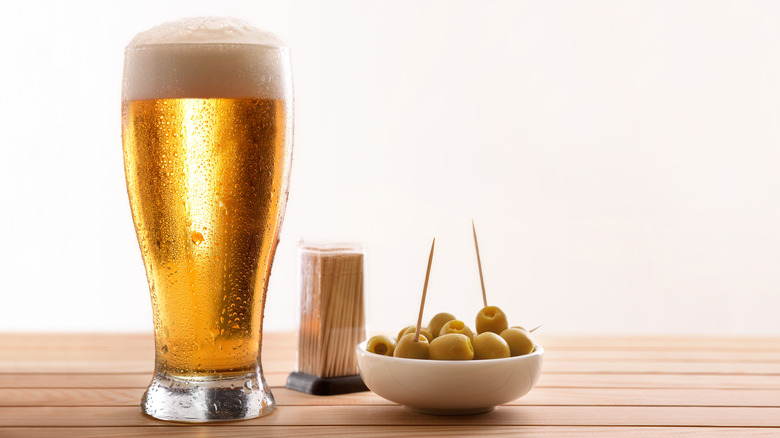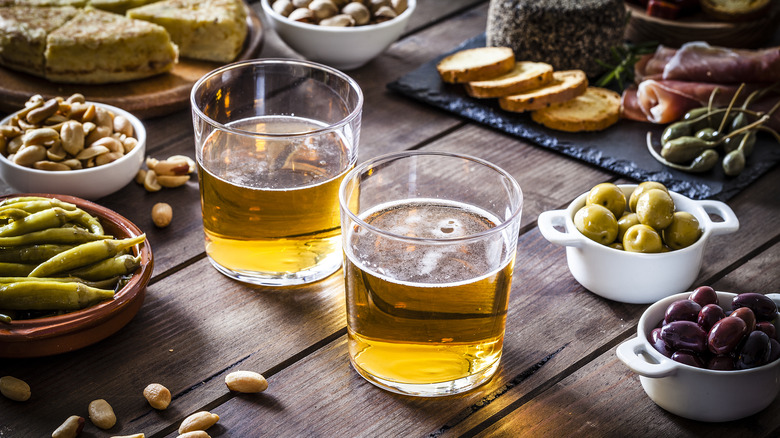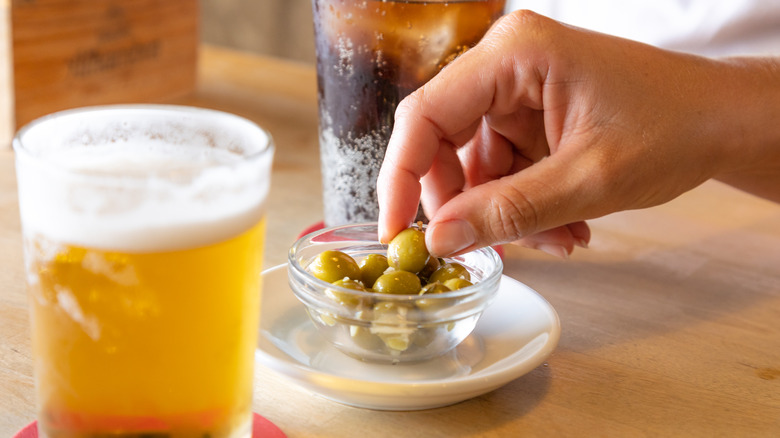Add Olives To Your Low-Quality Beer And Taste The Magic
American beer is often the butt of international jokes. Many tend to denigrate the big American macro brews such as Budweiser or Coors as being watery and flavorless. Tides started changing in the 1980s and '90s when the craft beer movement got into full swing in the U.S., but walk into any bar today and you're still more likely to find Bud Light on tap than a locally brewed hazy IPA.
We Americans may love our thin, inexpensive beers, but even traditionalists can admit that sometimes it's nice to switch things up. One way that Midwesterners do this is by dropping some olives into their brews. The combination of beer and green olives is typically called a "beertini," a kind-of cocktail that's also known as the Minnesota (or North Dakota, or Wisconsin, depending on where you are) Martini; or a Dirty PBR when made with Pabst Blue Ribbon beer. Generations of Americans living in the heartland, particularly those with physically demanding jobs, have ended their workdays by tossing a handful (give or take) of green olives into a glass of cold, low-brow American lager.
Olives and lager may not sound like the most intuitive combination, but they work on both a practical level and a gustatory one. It's so simple, it's hardly a cocktail, and yet when the beer and brine meet, the resulting flavor sensation is greater than the sum of its parts.
Down and dirty with a beertini
Blue-collar Midwesterners aren't the only folks who have ever gussied up a plain beer. For centuries, beer drinkers around the world have added a pinch of salt to beer. That's because small amounts of salt enhance and amplify the flavors of other ingredients, without imparting a noticeable salty flavor. Salt can mitigate bitterness in beers, a trait that can be particularly useful for improving bad beer. Since olives are salt-brined, plopping a few into a beer can result in a surprisingly bright-tasting, extra-refreshing beverage that's not salty but all-around more flavorful and more balanced.
Beertinis are not to be made with craft beer; for one thing, using widely available, mass-produced beers — be they draft, canned, or bottled — is kind of the point. And although light, refreshing, but arguably watery beers might be improved by the addition of salty olives, craft beers in general tend to be packed with carefully cultivated flavors that a big ol' salt bomb could easily destroy.
But otherwise, the perfect beertini is in the eye of the beer holder. You could drop in just an olive or two for some mild, slightly fruity saltiness, or pour in half a jar and let the olive flavor rip. You can add olive brine to the beer, or not. The olives have to be green — do NOT reach for black olives — but beyond that, you can go nuts experimenting with different green olives. Castelvetrano? Bleu cheese-stuffed? Go for it.
Wasting away again in Beertiniville
The beertini isn't a formal cocktail, to say the least. Its origins are unknown, and there's no standardized recipe, but that's part of its appeal. Its only two ingredients — beer, and green olives — you'll find in pretty much any bar, so a beertini is something you can treat yourself to virtually anywhere, anytime. It's a drink that requires no technique, just a couple of guiding principles: the beer has got to be cheap, and the olives have got to be green.
If you're not in the mood for saltiness (or maybe you're just trying to cut your sodium), you may be interested to know that people doctor up their cold beers with other flavors, too. The Michelada, AKA the unofficial day drink of Southern California, combines a crisp Mexican lager with tomato juice and hot sauce for a zesty kick. But if you don't feel like mixing up a batch of those, you could just add some hot sauce to your beer for an easy, kicky upgrade.


